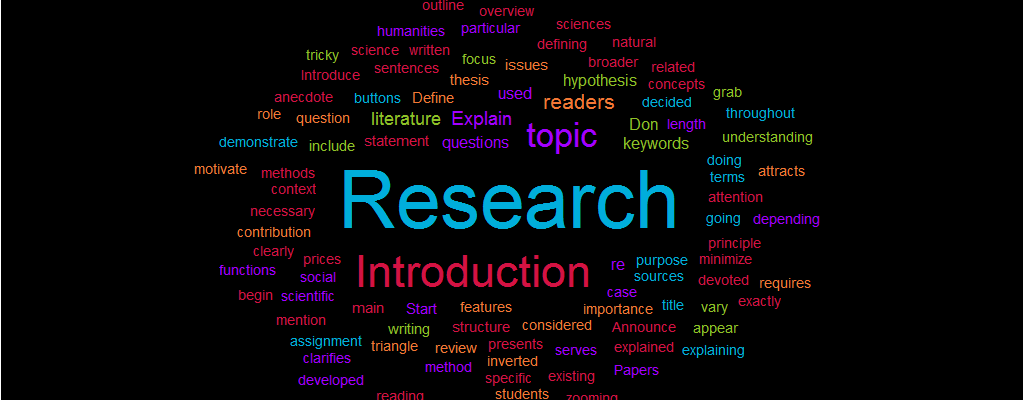How to Write an Introduction of a Research Paper
Publication Date:

For many students, the introduction of a research paper may appear to be the most tricky part of the assignment. Its length may vary depending on what kind of paper you’re going to write. The introduction serves a few different functions: it presents your topic, clarifies the context of the paper, attracts the attention of readers, and presents a thesis statement which will be explained and developed throughout the whole research.
- Announce the topic
Start your introduction with a topic. Explain what you’re going to focus on, and what questions you will answer. The introduction also must grab attention and motivate your readers to keep reading. As for the topic, begin with a broader context, defining general issues of your topic. After that, start zooming in on particular features of such issues, explaining to your readers what exactly your paper is about. This method is called an “inverted triangle”.
- Define your keywords
Any research paper written for publication requires you to provide a list of keywords which reflects considered issues. The title of the paper may also include keywords. We suggest mentioning a few keywords in your first sentences. Keywords make your paper more specific and serve as reminders for your readers to keep them focused on your topic.
- Define specific concepts and terms
You have to make sure that your readers understand all necessary terms and concepts. Explain such information at the very beginning, in your introduction. By doing this, you minimize the risk of your readers to puzzle on what you’re talking about.
This advice is of key importance in case you’re developing a new theory which uses an existing terminology.
- Introduce your topic
In case your paper is devoted to social science or humanities, you have an opportunity to use some creative methods. For example, you can introduce your topic through an anecdote or quotation. By doing this, you follow the “inverted triangle” principle, applying it in a more imaginary way and so taking a chance to demonstrate your writing skills.
- If you decide to start with an anecdote, make sure that it’s directly related to your topic and short. Note that its main purpose is to announce the topic.
- You can write a short story from your life that illustrates your topic.
- Don’t use this method in case you’re writing a paper on physical or natural sciences.
- Include a literature review
It depends on the length of your research paper, but most often, you have to include the literature review. Your readers must familiarize with sources devoted to your topic. Literature reviews also allow you to demonstrate your good preparation and perfect knowledge of the area.
- Don’t forget that your introduction must be concise, so don’t try to start a long discussion. Just write an overview of recent works and most relevant issues.
- Here you also can use the “inverted triangle” principle, pointing out broad themes that are important for the better understanding of your research.
- A good literature review explains the importance of your topic and provides readers with an understanding of the background of your research.
- Consider the used literature in relation to your own contribution
A comprehensive review of the used literature is a great way to explain the importance of your own work. Explain the role of the existing literature in your research and what is completely new about your own concept. Explain what gaps you found in other sources, and why you decided to fill them with a new perspective.
- Clarify your motivation
After you considered your work within a broader topic, explain why you decided to make your own contribution. Focus on the value of your research paper, its strong sides, and uniqueness.
- For example, when writing a scientific research, focus on advantages of your methods and used models.
- Point out what features of your work are fresh and unique. However, don’t write too many details in the introductory section.
- Define the purpose of your research and how it can be used.
Specify Questions of Your Research
- Indicate main questions of your paper
Once you’ve explained what is a role of your paper in studying some phenomenon, define what questions you decided to answer. Make sure that you addressed the main question of your research in the introduction and that your readers don’t see it for the first time.
- Research questions must be formulated clearly and concisely.
- The main question of your research may mention some keywords from the first sentences of your introduction or title.
- The research question must shape a considered issue and turn it into an understandable hypothesis.
- State your hypothesis
Now you have to articulate your hypothesis, which serves as your thesis statement. The thesis statement narrows your topic and helps in focusing on its particular features, thus clearly defining the purpose of your research. Explain how you came to this idea by referencing the used sources.
- Try not to use the word “hypothesis” in your work, or minimize its use. It will help you make your paper less rigorous and easier to read.
- When writing a scientific paper, briefly mention results of your research and explain how they are related to your hypothesis. Make your thesis statement clear and coherent.
- Write an outline
Sometimes an introduction must include a quick overview of the structure of your research paper. It represents the structure of sentences and logical sections.
- The outline isn’t always necessary, so ask your instructors to make sure what your introduction should consist of.
- Papers on natural sciences are usually written according to a strict defined structure. Make sure that you’re familiar with the required format.
- Papers on social science and humanities offer you more opportunities to change the structure of the paper.